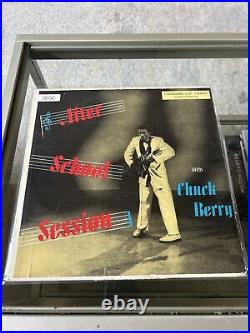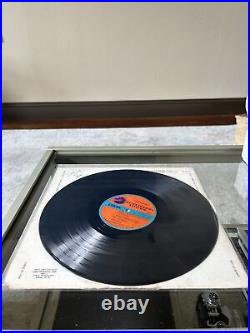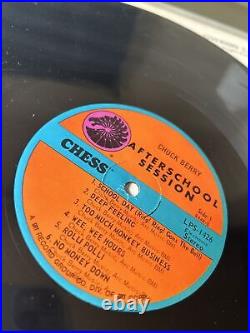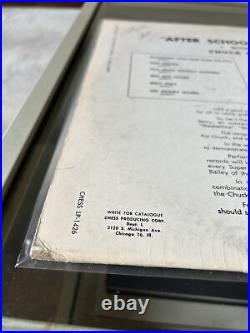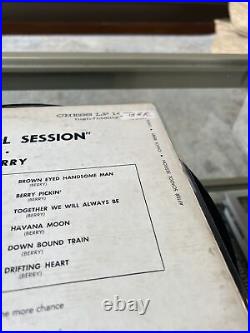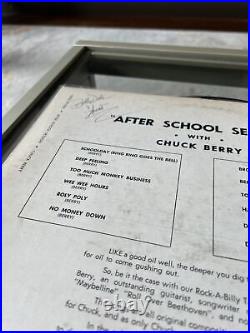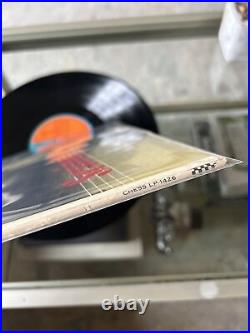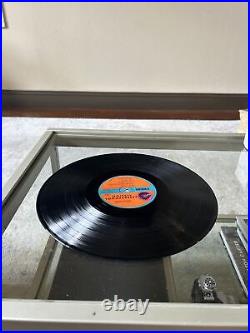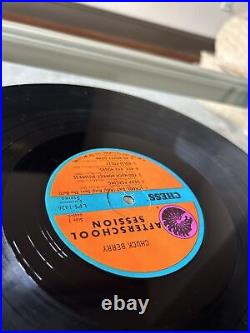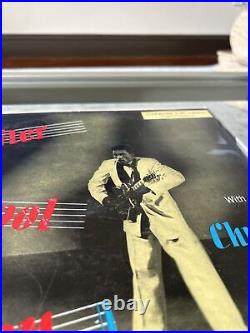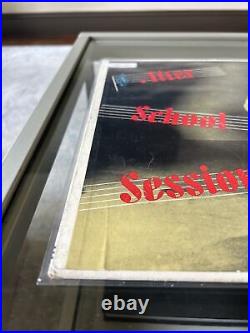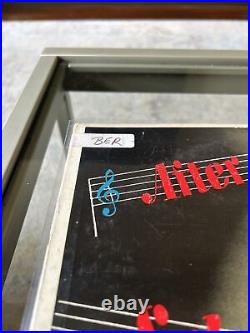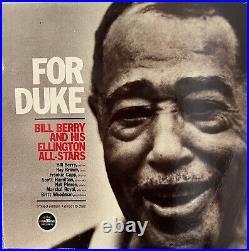
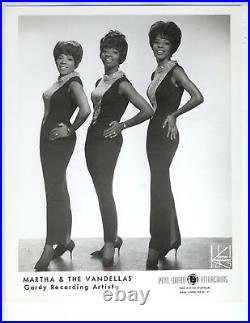


MARTHA & THE VANDELLAS VINTAGE ORIGINAL 8X10 INCH PHOTO FROM BWRRYrECODRING ARTISTS PENN-WORLD ATTRACTIONS 520 FIFTH VENUE NEW YORK 36 N. Martha and the Vandellas vand. Jpg (19534 bytes) One of Motown Records’ earliest and most exciting vocal groups, Martha and The Vandellas achieved two Top Ten hits before the ascendancy of The Supremes. Driven by Martha Reeves’ soulful, brassy lead vocals, the Vandellas became Motown’s earthier, more aggressive “girl group” alternative to the Supremes. Gif (3285 bytes) Martha Reeves, one of eleven children, was born in Eufaula Alabama on July 18, 1941. She moved with her parents Ruby and Elijah to Detroit, Michigan before her first birthday. Reeves spent most of her childhood singing and working in her grandfather’s church. She attended Russell Elementary on Detroit’s eastside and was taught vocals by Emily Wagstaff. Northeastern High School was where she studied voice under the direction of Abraham Silver, who also coached Florence Ballard and Mary Wilson of the Supremes, Bobby Rogers of the Miracles. Jpg (252315 bytes) First Martha and the Vandellas group photo (From L-R Martha Reeves, Annette Beard and Rosalind Ashford) After graduating from high school in 1959, Reeves joined the girl group called the Fascinations. They recorded their first record about 1960, backing Mike Hanks on “The Hawk” on Mah’s Records. They also backed Leon Peterson on “I Know You Know” on the Bobbin label in 1962. Their first big break was working with local singer J. Barnes on Won’t You Let Me Know. ” The 1962 single on Rich Records credited both Barnes and the Del-Phis and led to the answer record “Ill Let You Know on Check-Mate. In the late summer of 1960 Reeves met Rosalind Ashford and they were invited to join Annette Sterling and Gloria Williamson in the Del-Phis. After doing some local talent shows and jobs they recorded a single on Chess-Mate Records, a subsidiary of Chess Records in 1961. The Del-Phi”s recording that didn’t make the charts was “My Baby Won’t Come Back. Jpg (56305 bytes) Reeves as a solo entered and won a talent contest. The prize was a three day engagement at the Twenty Grand, a local nightclub where she sang as Martha LaVaille. On her last night, William “Mickey” Stevenson, an A&R and Berry Gordy’s right-hand man at Motown Records, approached Reeves, after hearing her sing, and gave her his card. In 1961 Reeves was hired as his secretary. One day Motown head Berry Gordy needed background singers in short order for a session; Reeves and her friends, Ashford and Beard, were called in. They sang behind Marvin Gaye on “Stubborn Kind of Fellow, ” his first hit in 1962 and Hitch Hike. A couple months later, Reeves again found her self in the right place at the right time. Stevenson had called over to the studio, where a union rep was checking to make sure the label was following the rule that a singer had to be on a mic when tracks were recorded. In Mary Well’s absence, Reeves sang “I’ll Have To Let Him Go, impressing Stevenson enough ask the Del-Phis to record “You’ll Never Cherish A Love So True (‘Til You Lose It). The session was a success, but Gloria decided she didn’t want to leave her job and left the group. The single was issued anyway on Mel-O-Dy as by the Vells. The rest of the group convinced Gordy that they were staying as a trio. Gordy then asked the girls to come up with a new name. They then called themselves Martha and the Vandellas, taking their name from Detroit street Van Dyke and Reeve’s favorite singer Della Reese before recording I’ll Have to Let Him Go. Jpg (571373 bytes) Come Get These Memories Signed to the newly formed Gordy label in September 1962 as Martha and The Vandellas, the group’s first hit was their second release, a beat ballad “Come Get These Memories” (#29 pop, #3 R&B 1963) and was Holland-Dozier-Holland’s first collaboration as a songwriting team. “Memories” was followed by two explosive Holland-Dozier-Holland dance records: “Heat Wave” (#4 pop, #1 R&B, 1963) and “Quicksand” (#8 1963). After being turned down by Kim Weston, a Mickey Stevenson and Marvin Gaye composition, “Dancing in the Street” was given to Martha and the Vandellas; who turned it into their biggest hit (#2, 1964). Their other big hits included “Nowhere to Run” (#8, pop, #5 R&B, 1965) and “I’m Ready for Love” (#9 pop, #2 R&B, 1966), “Jimmy Mack” (#10 pop, #1 R&B, 1967) and “Honey Chile”(#11 pop,, #5 R&B, 1967) were the last Holland-Dozier-Holland compositions they recorded, and were their last big hits. Beard retired in 1963 and was replaced by former Velvelette Betty Kelly; when Kelly left four years later she was replaced by Reeve’s younger sister Lois. Ashford quit in 1969 and was replaced by another ex-Velvelette Sandra Tilley. Tilley died during surgery for a brain tumor in 1981. The group disbanded in 1973 after giving a farewell concert on December 21, 1972, at Detroit’s Cobo Hall. Lois Reeves went to work for Al Green. Martha Reeves launched a solo career, but her recordings for MCA, Arista, and Fantasy through 1980 failed to sell well. As recounted in her 1994 autobiography Dancing in the Street, Reeves believes that the groups succession was undermined by Motown and Berry Gordy Jr’s. Obsession with the Supremes. An example being Jimmy Mack which was held from release for two years because it sounded too much like the Supremes then current singles. A strong personality Reeves clashed with Gordy demanding answers to business questions that most other Motown artist didn’t ask until years after they left the label. Struggling to maintain a hectic schedule of recording and performing, Reeves became addicted to prescription drugs, exacerbating emotional problems that led to nervous breakdowns and a period of institutionalization. Reeves has been drug free since 1977. In 1989 she, Ashford and Beard sued Motown for back royalties. In 1974 Reeves signed with MCA Records, Her debut solo album, Martha Reeves produced by Richard Perry, had a minor hit “Power of Love”. Other solo albums were We Meet Again, and Got To Keep Movin on Fantasy Records, and The Rest of My Life for Arista Records. Though her solo records have been critically acclaimed, Reeves has never achieved the success that she had enjoyed with the Vandellas. Reeves currently resides in Downtown Detroit after living twelve years in Los Angeles. She continues to tour and record; sometimes the Vandellas consists of her sisters Lois and Delphine. On special occasions, she performs with Beard and Ashford. Rosalind Ashford has just retired from Ameritech and Annette Sterling has worked at St. John’s Hospital as a phlebotomist for the last forty years. The Vandellas were inducted into the Rock and Roll Hall of Fame in 1995 Along with the Supremes, Martha & the Vandellas defined the distaff side of the Motown sound in the’60s. Their biggest hits, including “Heat Wave, ” “Dancing in the Street, ” and “Nowhere to Run, ” remain among the most potent and enduring dance records of the era. The vocal group was led by Martha Reeves who, along with fellow Detroit natives Annette Sterling Beard, Gloria Williams, and Rosalind Ashford, founded the Del-Phis in 1960. After Reeves landed a secretarial position at the offices of Motown Records, the Del-Phis were tapped to record a one-off single for the label’s Melody imprint, which they cut under the name the Vels. The single fizzled, and Williams exited, reducing the group to a trio. After backing Marvin Gaye on the superb 1962 record “Stubborn Kind of Fellow, ” they were renamed Martha & the Vandellas, taking inspiration from Detroit’s Van Dyke Street and Reeves’ heroine, Della Reese. When singer Mary Wells failed to show up for a recording date, musicians’ union rules demanded that a vocalist be found to fulfill contractual obligations. As a result, Reeves was yanked from the secretarial pool and laid down what would become Martha & the Vandellas’ first record, 1963’s I’ll Have to Let Him Go. Following another Top Ten hit, “Quicksand, ” Beard retired, and was replaced by former Velvelette Betty Kelly. After singer Kim Weston turned down the Marvin Gaye/Ivy Jo Hunter/Mickey Stevenson composition “Dancing in the Street, ” the song was shuttled to Martha & the Vandellas; refashioned by Holland-Dozier-Holland to fit the group’s formula, the anthem became their biggest hit and definitive statement, reaching number two in the summer of 1964. In 1967, Kelly exited, and was replaced by Reeves’ younger sister Lois; on subsequent releases, the group was billed as Martha Reeves & the Vandellas. 1967’s “Jimmy Mack” and “Honey Chile” were the last records overseen by the Holland-Dozier-Holland team before their defection from Motown, and were also the final significant Vandellas hits. In 1968, Martha Reeves fell seriously ill, and in 1969 Ashford departed, with another former Velvelette, Sandra Tilley, assuming her position. The trio continued unsuccessfully for a few more years before breaking up in the wake of a December 1972 farewell performance at Detroit’s Cobo Hall. After Motown relocated its corporate offices to Los Angeles (a move Reeves denied she was privy to), the singer, who had begun a solo career, sued to have her contract with the label annulled. In her 1994 autobiography, Dancing in the Street, she charged that the Vandellas’ career, though highly successful in its own right, could have been even greater had Motown founder Berry Gordy, Jr. Given their music the same obsessive attention he afforded to Diana Ross & the Supremes. Martha Reeves Reeves recorded her debut solo effort, Martha Reeves, for MCA in 1974. Though a few more LPs followed, including 1976’s The Rest of My Life and 1978’s We Meet Again, she received little notice on her own, and eventually suffered a pair of nervous breakdowns that led to a brief period of institutionalization. Lois Reeves, meanwhile, went on to work with Al Green, while Sandra Tilley retired from music; she died in 1982 following surgery on a brain tumor. In 1989, Martha Reeves, Annette Beard, and Rosalind Ashford successfully sued Motown for back royalties, and occasionally reunited for performances in the’90s. Reeves also continued as a solo artist, and in addition performed with a Vandellas unit consisting of Lois and a third sister, Delphine. She released another solo album, the independent Home to You, in 2004. From 2005 through 2009, she served on Detroit’s city council. Afterward, she aligned with a non-profit organization to help musicians receive royalties, and she continued to be an active performer with the Vandellas. This is a listing of all the singles and albums released by Motown girl group Martha and the Vandellas. 12 of their singles reached the Billboard Top 40 singles chart in the US while 22 singles registered on the Top 40 of the US R&B chart, two of which went to #1 on the chart. Six of the singles were Top 10 pop singles while ten were Top 10 R&B singles. Of all the songs they released, 25 of their singles were Hot 100 pop singles with 26 registering on the Hot 100 R&B singles chart. Contents 1 Albums 1.1 Compilation albums 2 Singles 2.1 The Del-Phis 2.2 The Vells 2.3 Martha and the Vandellas 2.4 Martha Reeves and the Vandellas 3 References Albums All Martha and the Vandellas albums released on the Motown subsidiary Gordy. Year Album Peak chart positions US 1963 Come and Get These Memories – Heat Wave 125 1965 Dance Party 139 1966 Watchout! 116 Martha and the Vandellas’ Greatest Hits 50 1967 Martha and the Vandellas Live! 144 1968 Ridin’ High 167 1969 Sugar’n’ Spice – 1970 Natural Resources – 1972 Black Magic 146 “-” denotes releases that did not chart Compilation albums All Motown releases: Year Album – Greatest Hits, Vol. 2 – Greatest Hits, Vol. The R&B chart numbers from that period come from Cash Box magazine, a Billboard competitor at the time. 1The lead vocals on those songs were by Gloria Williams 2 The song featured background vocals by the Four Tops and The Andantes 3″Taking My Love (And Leaving Me)” peaked at number two on the Billboard Bubbling Under Hot 100 chart in 1969 4″In and Out of My Life” peaked at number two on the Billboard Bubbling Under Hot 100 chart in 1972 5″Tear It On Down” peaked at number three on the Billboard Bubbling Under Hot 100 chart in 1972 Martha and the Vandellas (known from 1967 to 1972 as Martha Reeves and the Vandellas) were an American all-female vocal group formed in 1957. The group achieved fame in the 1960s with Motown. Selected Members of the group were inducted into the Rock and Roll Hall of Fame in 1995. Formed in 1957 by friends Annette Beard, Rosalind Ashford and Gloria Williams, the group eventually included Martha Reeves, who moved up in ranks as lead vocalist of the group after Williams’ departure in 1962. The group signed with and eventually recorded all of their singles for Motown’s Gordy imprint. The group’s string of hits included “Come and Get These Memories”, “Heat Wave”, “Quicksand”, “Nowhere to Run”, “Jimmy Mack”, “Bless You” and “Dancing in the Street”, the latter song becoming their signature single. During their nine-year run on the charts from 1963 to 1972, Martha and the Vandellas charted over twenty-six hits and recorded in the styles of doo-wop, R&B, pop, blues, rock and roll and soul. Ten Vandellas songs reached the top ten of the Billboard R&B singles chart, including two R&B number ones, and six Top Ten Pop Hits on the Billboard Hot 100. Ashford & Beard, along with then-lead vocalist Gloria Williams, performed at local clubs, private events, church benefits, YMCA events and school functions. [1][2][3] They were also being coached by Maxine Powell at Detroit’s Ferris Center. [1] One of the group’s first professional engagements was singing background for singer Mike Hanks. [4] The group originally had up to six members, shortened to four. After another member left the group, she was replaced by Alabama-born vocalist Martha Reeves, who had been a member of a rival group, the Fascinations and had also been a member of another group, the Sabre-Ettes. In 1960, the group signed their first recording contract with Checker Records, releasing the Reeves-led “I’ll Let You Know”. The group then recorded for Checkmate Records, a subsidiary of Chess Records, recording their first take of “There He Is (At My Door)”. That record, featuring Williams on lead vocals, also flopped. After Motown staffer Mickey Stevenson noticed Reeves singing at a prominent Detroit club, he offered her his business card for an audition. [5] Reeves showed up at Motown on a wrong date (Motown auditions were held at Thursdays, while Reeves showed up to Motown’s Hitsville USA studios on a Tuesday). Stevenson, initially upset, told Reeves to look out for clients and other matters. Soon Reeves became Stevenson’s secretary and later was responsible for helping acts audition for the label. [6] By 1961, the group, now known as The Vels, were recording background vocals for Motown acts. Prior to her success as lead singer of The Elgins, Sandra Edwards (then going by her surname Maulett) recorded the song “Camel Walk”, in 1962, which featured the Vels in background vocals. That year, the quartet began applying background vocals for emerging Motown star Marvin Gaye, singing on Gaye’s first hit single, “Stubborn Kind of Fellow”[7] After Mary Wells failed to make a scheduled recording session feigning a short illness, the Vels recorded what was initially a demo recording of “I’ll Have to Let Him Go”. Motown was so impressed by the group’s vocals – and Martha’s lead vocals in the song – that the label CEO Berry Gordy offered to give the group a contract. Figuring that being in show business was too rigorous, Williams opted out of the group. With Williams out, the remaining trio of Ashford, Beard and Reeves renamed themselves The Vandellas, after Detroit’s Van Dyke Street and Reeves’ favorite singer, Della Reese. It became the Vandellas’ first Top 40 recording, reaching number twenty-nine on the Billboard Hot 100 and peaking at number six on the R&B chart. Their second hit, “Heat Wave”, became a phenomenal record for the group, [8] reaching number four on the Hot 100 and hitting number one on the R&B singles chart for five weeks. On the single and album, the song was titled “Heat Wave”. It was sometime later that the song was retitled to avoid confusion with the Irving Berlin song. The group’s success continued with their second Top Ten single and third Top 40 single, “Quicksand”, which was another composition with Holland-Dozier-Holland[8] and reached number eight pop in the late fall of 1963. Around that time, Annette, who was pregnant with her first child and set to get married, chose to leave her singing career behind by 1964. [9] Betty Kelley, formerly of the Velvelettes, was brought in shortly afterward to continue the Vandellas’ rise. The next two singles, “Live Wire” and “In My Lonely Room” (#6 R&B Cashbox) were less successful singles, failing to reach the Top 40. However, their next single, “Dancing in the Street”, rose up to #2 on the Billboard Hot 100 and also found global success, peaking at #21 on the UK Singles Chart in 1964. In 1969, “Dancing in the Street” was re-issued and it was plugged heavily on radio stations. It did not take long for the song to peak at #4 in the UK, thus making the song one of the all-time favourite Motown single releases ever. [10] Between 1964 and 1967, singles like “Wild One” (US #34), “Nowhere to Run” (US #8; UK #26), “Love (Makes Me Do Foolish Things)” (US #70; R&B #22), “You’ve Been in Love Too Long” (US #36), “My Baby Loves Me” (US #22; R&B #3), “I’m Ready for Love” (US #9; R&B #2; UK #29) and “Jimmy Mack” (US #10; R&B #1; UK #21) kept the Vandellas on the map as one of the label’s top acts. The Vandellas’ popularity helped the group get spots on The Ed Sullivan Show, The Mike Douglas Show, American Bandstand and Shindig! . Throughout this period, the Vandellas had also become one of the label’s most popular performing acts. Personnel changes Motown struggled to find good material for many of their acts after the exit of Motown contributor and Reeves’ mentor William “Mickey” Stevenson in 1967 and Holland-Dozier-Holland in early 1968, but after their former collaborators left the label, the Vandellas initially continued to find success with the Richard Morris-produced singles “Love Bug Leave My Heart Alone” (US #25; R&B #14) and “Honey Chile” (US #11; UK #30; R&B #5) added to their already extended list of charted singles. In the summer of 1968, the group joined The Supremes, The Temptations, The Four Tops and Marvin Gaye in performing at the Copacabana though much like albums from the Four Tops and Gaye, a live album of their performance there was shelved indefinitely. That same year, label changes had started to take effect, and Gordy focused much of his attention on building the Supremes’ as well as Diana Ross’ burgeoning upcoming solo career that would follow in 1970. The Vandellas’ sound (and the sound of many Motown acts with the exception of Marvin Gaye, The Temptations, The Marvelettes, and Stevie Wonder) suffered as a result. [5][11] However it was the infighting among the members of the Vandellas that led to their problems. Kelley was the first to be let go after reportedly missing shows, as well as getting into altercations with Reeves. [5][12] There were many instances where these “fights” happened on stage. Kelley was fired in 1967 and was replaced by Martha Reeves’ sister Lois. [7][12] Simultaneously, the group’s name was officially changed to Martha Reeves and the Vandellas, to conform with the company’s recent changes of The Supremes’ and The Miracles’ names to reflect their featured lead singers. During this time, Vandellas records including “(We’ve Got) Honey Love”, “Sweet Darlin'” and “Taking My Love and Leaving Me” were issued as singles with diminishing success. Among their late 1960s hits was “I Can’t Dance to That Music You’re Playing”, which featured singer Syreeta Wright singing the chorus, and peaked at number forty-two. Reeves reportedly hated singing the song sensing it “close to home”. In 1970, the group issued Motown’s first protest single, the controversial anti-war song, “I Should Be Proud”, which peaked at a modest forty-five on the R&B singles chart. The song was uncharacteristic of the Vandellas and did nothing to promote the group. On some stations, the flip-side “Love, Guess Who” was played instead. In 1971, the group scored an international hit with “Bless You” (produced by the Jackson 5’s producers The Corporation). The song peaked at number fifty-three on the American pop singles chart (the biggest peak of Vandellas’ seventies singles), and number twenty-nine on the R&B singles chart. “Bless You” was their first UK Top 40 hit since “Forget Me Not”, with the song reaching number thirty-three there. “Bless You” became a top 20 hit in Canada. It was to be the last Billboard Hot 100 hit single for the group. That record also signaled the end of the Motown era. After two successive Top 40 R&B singles, the ballad “In and Out of My Life” (#22 US R&B) and the Marvin Gaye cover, “Tear It On Down” (#37 US R&B), the group disbanded following a farewell concert, held at Detroit’s Cobo Hall on December 21, 1972. The next year, Reeves announced plans of starting a solo career. [13] At the same time, Motown Records moved its operations to Los Angeles. When Reeves did not want to move, she negotiated out of her contract with Motown, [14] signing with MCA in 1974, and releasing the critically acclaimed self-titled debut album, Martha Reeves. [5] Despite rave reviews of her work, neither of Reeves’ post-Vandellas/Motown recordings produced the same success as they had the decade before. After living what she called “a rock & roll lifestyle” of prescription pills, cocaine and alcohol, Reeves sobered up in 1977, overcoming her addictions and becoming a born-again Christian. [5][12] Epilogue After the Vandellas’ split, Reeves’ sister Lois sang with the group Quiet Elegance and sang background for Al Green, [12][15][16][17] while Tilley retired from show business in the late 1970s, suddenly dying of a brain aneurysm in 1981 at the age of thirty-eight. Original member Gloria Williams, who retired from show business when she left the group, died in 2000. In 1978, Reeves and original Vandellas Ashford and Beard reunited at a Los Angeles benefit concert for actor Will Geer. In 1983, Reeves successfully sued for royalties from her Motown hits and the label agreed to have the songs credited as Martha Reeves and the Vandellas from then on. [5][12] That year, Reeves performed solo at Motown 25, [18] which alongside some of their songs being placed on the Big Chill soundtrack, helped Reeves and the Vandellas gain a new audience. In 1989, original members Ashford and Beard also sued Motown for royalties. During this time, the original trio were inspired to reunite both as a recording act and in performances. [5][12] They were offered a recording contract with Ian Levine at Motorcity Records who issued the group’s first single since the Vandellas disbanded seventeen years earlier called Step Into My Shoes. Although they are no longer singing together full-time, Martha Reeves and the Vandellas have occasionally reunited for various concerts. Currently, Ashford, whose full name now is Rosalind Ashford-Holmes, and Beard, whose full name now is Annette Beard-Helton, continue to perform with other singers, most notably Roschelle Laughhunn, as The Original Vandellas. ” Reeves, with her sisters Lois and Delphine Reeves, tour as “Martha Reeves and the Vandellas. From 2005 to 2009, Reeves held the eighth seat of Detroit’s city council. She has since lost her seat and told the press that she would continue performing. [19] A remake of the song “Nowhere To Run, ” sung by Arnold McCuller, is heard in the film “The Warriors” during the scene in which the Gramercy Riffs call a hit on the Warriors. In a Season One episode of the television show The Golden Girls, Blanche describes her car as the noisiest thing to come out of Detroit since Martha & The Vandellas. [20] Candice Bergen, who hosted the Saturday Night Live episode on which Martha Reeves appeared in its inaugural season, made sure that Martha Reeves and the Vandellas were a presence throughout her “Murphy Brown” series. The group’s picture was displayed prominently in Murphy’s office. When Aretha Franklin guest starred and Murphy tried to sing with her, Franklin stopped her, saying, . I’m not Martha, and you ain’t no Vandella. ” Awards and accolades They won a Grammy in 1999, they were nominated for Best R&B Vocal Performance by a Duo or Group for “(Love Is Like A) Heat Wave”, in 1964, Martha and the Vandellas’ “Dancing in the Street was inducted to the Grammy Hall of Fame in 1999. In 1993, Martha Reeves and the Vandellas were awarded the Pioneer Award by the Rhythm & Blues Foundation. Except for pre-Vandellas member Gloria Williamson and Vandellas member Sandra Tilley, all members of the group were inducted to the Rock & Roll Hall of Fame in 1995, becoming the second all-female group to be inducted. They were inducted by rock group The B-52’s, whose frothy dance music was inspired by the Vandellas. [21][22] They were inducted into the Vocal Group Hall of Fame in 2003. [19] Two of their singles, “(Love Is Like a) Heat Wave” and “Dancing in the Street” were included in the list of The Rock and Roll Hall of Fame’s 500 Songs that Shaped Rock and Roll. In 2004, Rolling Stone ranked the group #96 on their list of the 100 Greatest Artists of All Time. [23] Always concert favorites, Martha Reeves and the Vandellas were nominated for UK Festival Awards in 2010 and 2011 as Best Headliner. Martha and the Vandellas was inducted into the inaugural class of the Official Rhythm & Blues Music Hall of Fame at Cleveland State University August 2013 Impact This section possibly contains original research. Please improve it by verifying the claims made and adding inline citations. Statements consisting only of original research should be removed. (May 2013) (Learn how and when to remove this template message) Regarded for their early and mid-1960s work, some of the Vandellas’ popular recordings have become part of American culture with their 1964 standard, “Dancing in the Street, ” being the obvious example. One of the most covered and popular songs in rock and roll history, “Dancing in the Street” was covered several times including a 1982 live recording by rock band Van Halen and a 1985 duet by rockers David Bowie and Mick Jagger. “Dancing in the Street” is consideredwho? To be the “Motown Anthem” by many. Martha and the Vandellas 1963 hit, “(Love Is Like a) Heat Wave, ” was the first song that signified the Motown sound or the “Sound of Young America” with its backbeat and bouncing rhythms. 1965’s “Nowhere to Run” has been featured during sports events. 1967’s “Jimmy Mack” inspired what Reeves later said was a “virtual legend” of the name of the song Jimmy Mack. They were inducted to the Rock & Roll Hall of Fame in 1995 becoming just the second all-female group to be inducted and the fifth group in the Motown roster to be inducted. They were inducted to the Vocal Group Hall of Fame in 2003. They were nominated for a Grammy Award for Grammy Award for Best R&B Performance in 1964 for their hit song “Heat Wave” “Dancing in the Street” was included in the United States Library of Congress’ National Recording Registry for its historical, artistic and cultural significance in 2006. This item is in the category “Music\Vinyl Records”. The seller is “memorabilia111″ and is located in this country: US. This item can be shipped to United States, Canada, United Kingdom, Denmark, Romania, Slovakia, Bulgaria, Czech Republic, Finland, Hungary, Latvia, Lithuania, Malta, Estonia, Australia, Greece, Portugal, Cyprus, Slovenia, Japan, China, Sweden, Korea, South, Taiwan, Belgium, France, Ireland, Netherlands, Poland, Spain, Italy, Germany, Austria, Bahamas, Israel, Mexico, New Zealand, Singapore, Switzerland, Norway, Saudi Arabia, Ukraine, United Arab Emirates, Qatar, Kuwait, Bahrain, Croatia, Republic of, Malaysia, Chile, Colombia, Costa Rica, Dominican Republic, Panama, Trinidad and Tobago, Guatemala, El Salvador, Honduras, Jamaica, Antigua and Barbuda, Aruba, Belize, Dominica, Grenada, Saint Kitts-Nevis, Saint Lucia, Montserrat, Turks and Caicos Islands, Barbados, Bermuda, Brunei Darussalam, Bolivia, French Guiana, Guernsey, Gibraltar, Guadeloupe, Iceland, Jersey, Jordan, Cambodia, Cayman Islands, Liechtenstein, Sri Lanka, Luxembourg, Monaco, Macau, Martinique, Maldives, Oman, Pakistan, Paraguay, Reunion, Uruguay, Russian Federation.
- Artist: MARTHA AND THE VANDELLAS
- Format: PHOTO
- Release Title: NONE


